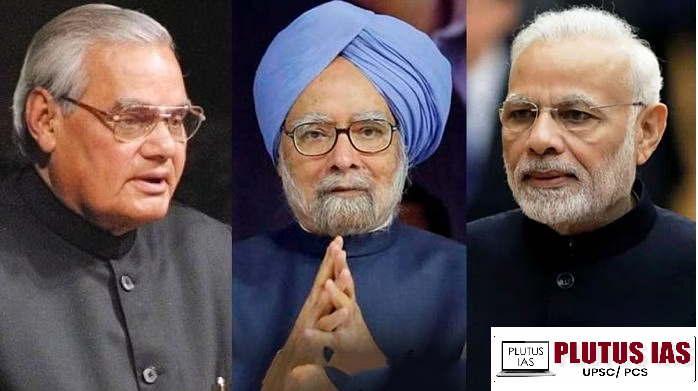30 Dec Role of PMO in Shaping foreign policy
SYLLABUS MAPPING:
GS-2-International relations- Role of PMO in Shaping foreign policy
FOR PRELIMS:
Various foreign policy initiatives, agreements, and treaties under the leadership of different PMs: 123 Agreement Pokhran test, Kargil war, URI strike etc.
FOR MAINS
What is significant about foreign policy ton fulfil national interest? Evaluations of PMO as a prime institution in foreign policy making.
Why in the news?
The tribute by India’s External Affairs Minister, Dr S. Jaishankar, to the late former Prime Minister, in which he expressed sorrow over his passing, has made headlines because of its profound acknowledgement of the late leader’s dual legacy both in economic reforms and foreign policy. Dr Jaishankar’s statement highlights the former Prime Minister’s key role in shaping India’s economic transformation and strategic foreign policy shifts, marking him as a pivotal figure in India’s modern history. In particular, the tribute underlined that the late Prime Minister was not only recognized for his economic reforms but was also instrumental in strategic corrections that influenced India’s global positioning. Dr Jaishankar, who had the privilege of working closely with him, emphasized the former leader’s kindness and courtesy, which added a personal touch to his public reflection.

Legacy of Atal Bihari Vajpayee:
1. 1998 Nuclear Tests: Vajpayee’s government conducted nuclear tests in May 1998, asserting India’s position as a nuclear power. The tests were driven by security concerns, particularly from Pakistan and China. While initially met with international condemnation, the decision helped eliminate India’s nuclear ambiguity, leading to global recognition of India’s nuclear status. Vajpayee’s stance on nuclear deterrence was pivotal in shaping India’s future security policy.
2. Diplomatic Engagement:
United States: Despite sanctions after the tests, Vajpayee’s diplomacy with the U.S., led by Foreign Minister Jaswant Singh, paved the way for improved relations and the eventual Indo-U.S. nuclear deal in 2005.
China: Vajpayee worked to stabilize relations with China, marking a historic visit to Beijing in 2003. He initiated confidence-building measures and secured China’s recognition of Sikkim as part of India.
Pakistan: Vajpayee sought peace with Pakistan, exemplified by the Lahore Declaration in 1999. However, the Kargil War later tested his resolve. Despite the conflict, he maintained a peace dialogue with Pakistan, underscoring his commitment to diplomacy.
Israel and West Asia: He also strengthened ties with Israel and engaged strategically with Iran, enhancing India’s influence in West Asia.
3. Global Vision: Vajpayee’s foreign policy was marked by a balance of security and diplomacy. His leadership solidified India’s nuclear deterrence, expanded strategic partnerships, and elevated India’s role on the global stage, laying the foundation for its rise as a major power.
Manmohan singh nuclear test and Pakistan engagement:
1. India-US Nuclear Deal (2005-2008): Manmohan Singh’s push for the India-US nuclear deal was hailed as a diplomatic breakthrough but also faced considerable opposition.
2. Overdependence on the U.S.: While the deal opened up access to nuclear technology and fuel, critics argued that it made India overly dependent on the U.S. for its nuclear energy needs. The agreement required India to place its civilian nuclear facilities under IAEA safeguards, but this was seen as compromising India’s strategic autonomy. The deal was viewed by some as a concession to U.S. power, potentially limiting India’s freedom in future nuclear policy decisions.
3. Strategic Concerns: The deal was also criticized for essentially legitimizing India’s nuclear status without the obligations of the Nuclear Non-Proliferation Treaty (NPT). Many analysts believed this set a dangerous precedent, undermining global non-proliferation efforts. Moreover, Pakistan viewed the agreement as a destabilizing factor in South Asia, as it strengthened India’s nuclear capabilities without similar concessions to Pakistan. Critics argued that the deal could fuel an arms race in the region.
4. Domestic Fallout: The deal was highly controversial domestically. Opponents within India, including several political parties, feared it would constrain India’s strategic autonomy, tying the country closer to U.S. interests. Despite the approval of the deal by Parliament, many felt Singh had compromised too much for the sake of international recognition.
Engagement with Pakistan: Manmohan Singh’s Diplomatic Journey:
1. Early Optimism and Fragile Progress: Singh’s administration aimed to improve ties with Pakistan, restarting peace talks in 2004 and enhancing confidence-building measures, such as resuming transportation links between Kashmir regions. However, these efforts were undermined by unresolved issues like Kashmir, cross-border terrorism, and military tensions.
2. Mumbai Attacks: A Turning Point: The 2008 Mumbai attacks, carried out by Pakistan-based terrorists, marked a significant setback. India’s demand for action against the attackers was met with Pakistan’s inaction and denial, leading to a sharp decline in bilateral relations. Critics argued that Singh’s dialogue-focused approach failed to address Pakistan’s reluctance to combat terrorism.
3. Stalled Dialogue and Criticism: Following the Mumbai attacks, the peace process effectively stalled. While Singh’s restraint in avoiding military escalation was noted, critics claimed his diplomacy lacked the leverage and strategy needed to compel Pakistan to act against cross-border terrorism, ultimately emboldening Islamabad.
PM Modi’s Greater Engagement and Multi-Alignment:
India’s future foreign policy will need to strike a balance between engagement with global powers, regional security concerns, and internal growth. As a rising global power, India’s strategic autonomy, economic dynamism, and diplomatic initiatives must align with its national interests. A careful mix of traditional alliances, multilateral engagement, and forward-thinking policies will help India overcome the challenges it faces, ensuring that it remains a prominent player in shaping global affairs in the years to come.
Download Plutus IAS Current Affairs (Eng) 30th Dec 2024
Prelims Question:
Mains Question:
Q. Discuss the key challenges and strategies that India must adopt to navigate its foreign policy in a multipolar world. How can India balance its relations with major powers while ensuring regional stability and energy security?
(250 words, 15 marks)




No Comments